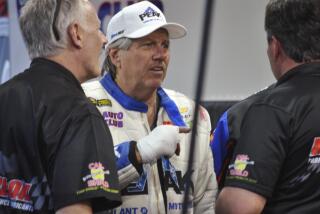For Safety’s Sake : NASCAR Has Come a Long Way to Protect Drivers--but Still Has a Long Way to Go
- Share via
It was 1964 at Riverside and the car drifted into the Turn 6 wall . . . and a helmeted head was jolted through the open window . . . scraped the concrete . . . and Joe Weatherly died.
The next season, netting over the window was required to keep drivers’ heads inside. And shoulder harnesses--Weatherly hated them and used only a seat belt--became mandatory.
It was 1964 at Charlotte, and the car was in a horrific crash with those of Junior Johnson and Ned Jarrett . . . gasoline spilled into the cockpit and ignited . . . and Fireball Roberts burned . . . and a few weeks later died.
In 1965, the fuel cell, adapted from military aviation, was required on all NASCAR cars.
The safety lessons of auto racing are learned the hard way, evolution bought with blood and, too often, lives. Twenty-seven Winston Cup drivers have died because of track accidents since NASCAR was founded in 1948, the most recent being Rick Baldwin last Thursday after 11 years in a coma, the result of a qualifying wreck at the Michigan International Speedway in 1986.
In each case something was learned to keep others alive.
But not in time for Weatherly, Roberts, Baldwin and the 24 others.
“We’re trying to be a step ahead now, trying not to react when something happens but trying to prevent that something from happening,” says Gary Nelson, Winston Cup’s racing director.
From a stock car driven to the track and raced to a roll bar to a roll cage, there’s a continuing evolutionary process. This year’s vertical tube behind the front window is nicknamed “the Earnhardt bar” because in crashes involving Dale Earnhardt, Ernie Irvan and Ricky Craven in 1996, roofs were nearly crushed and heads were threatened.
Some of the safety features designed to allay the damage caused in accidents are accidents themselves. The roof flaps, which deploy when a car turns around, keep the machine on the ground and are the result of testing a Rube Goldberg trunk-lid device that didn’t work.
“That was where we got ahead of the curve,” Nelson says.
“You look at the flaps these days and say, ‘Man, that’s neat.’ Well, why didn’t we have them in 1992, when Rusty Wallace’s car got airborne twice in the season and other cars took off like leaves in the wind and hit the ground hard? Darrell Waltrip went through it, Rusty went through it a couple of times, and they’re still out here racing. But we knew we had a potential problem.”
The solution seemed to be a pop-up trunk lid with straps to force the car’s back end down in a crash. A wind-tunnel test indicated that Nelson and the crew were onto something, so they took the NASCAR jet to an abandoned airstrip in South Carolina, put a Ford, Chevrolet and Pontiac, each equipped with a pop-up trunk lid, on a flatbed in the jet wash.
The plane was turned on, one of the trunk lids blew off and NASCAR officials, with visions of flying sheet-metal decapitating customers in the stands, abandoned the idea. Then somebody noticed that only the top eight inches of the trunk lids were needed to hold down the car, roof flaps were tried and soon were made mandatory.
And the cars of Wallace and Waltrip--and everyone else--stayed on the ground.
But not off the wall.
“Everybody who wrecks now is driving hurt the next week,” says Waltrip. “You look at the cars today, the reason they’re faster than they were back when I started is because they’re smaller. . . . Today, on the driver’s side, there is no ‘crush factor.’ You are there, and when you get slammed into the wall on the driver’s side, you have paid the price.”
In Craven’s case, the price was a broken shoulder, a concussion, two broken ribs and assorted bruises that cost him starts in races this year after a crash while practicing at Texas Motor Speedway.
“Darrell’s right,” he says. “When you see a driver get out of the car and wave to the crowd that he’s all right, well, he’s not all right. He might not hurt now, but he’s going to hurt tomorrow.”
Craven’s case shows how much force is generated when a car going 180 mph comes to an instant stop.
“We looked at his accident, and there was no intrusion at all,” Nelson says.
By that he means, no metal touched Craven. His injuries were the result of the force generated by the instant stop. The answer, Nelson and Craven say, lies in the seats and tests are being made to remedy the problem.
Correction comes quickly and is the product of a closed society that is motor racing.
“We’ve got the car builders and the car designers and crew chiefs and drivers, and it’s unique,” Nelson says. “In government, you’ve got the car manufacturers in Detroit and officials in Washington that pass laws. And you’ve got patrolmen on the highway. Well, if something happens, it takes years to pass laws and for things to become standard equipment. Here it takes hours.”
Studies are ongoing and not advertised because sometimes the “solution” doesn’t work. Sometimes it makes matters worse.
Air bags were tried and rejected.
“Some of the problems we found with them, we’re reading about in the paper now, two years later,” Nelson says.
The idea is that everybody has the same goal, which is for a driver to walk off the track at day’s end.
“We don’t get opposition,” Nelson says. “They know this is their livelihood. It’s important to them. It’s their friends out there driving the cars. It’s my friends.”
And the last thing they want is to go to their friends’ funerals.
More to Read
Go beyond the scoreboard
Get the latest on L.A.'s teams in the daily Sports Report newsletter.
You may occasionally receive promotional content from the Los Angeles Times.










